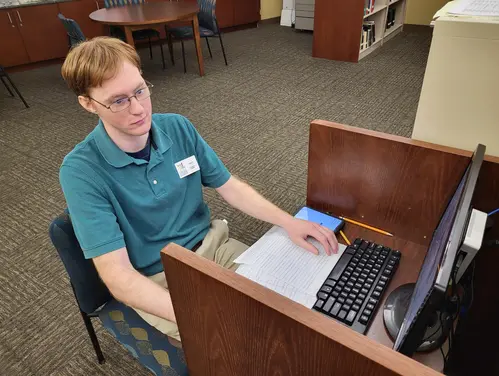The calm, mostly blank face on the Zoom screen speaks in a soft, even monotone as it describes when the man realized what he wanted to do with his life.
“Really, I’ve wanted to do geology, paleontology, since 2nd grade,” Kent Isaacson explains. “Then, it kind of morphed into museums… I’ve pretty much always wanted to do this. I’m glad they found a way to give me a chance.”
The resume that Kent created with help from IowaWORKS and the Vocational Rehabilitation Services division of Iowa Workforce Development says Isaacson graduated from Fort Hays University in Kansas with a master’s degree in geoscience, emphasis in museum studies and paleontology. That was in 2018 – the beginning of a long, frustrating struggle to do the work that he loves.
The problem? Job interviews – interviews that again and again went nowhere.
Kent understands that he doesn’t present himself the way people expect. He’s been diagnosed with attention deficit disorder and a learning disability, “plus, I think I process stuff a little more slowly than most people.” From the outside, the combination of all of this can make him look timid, flat, and disinterested – a job candidate that’s easy for hiring managers to pass by.
“He’s very smart. He knows the material,” said Lewis Litzel, a counselor with the Vocational Rehabilitation Services division of Iowa Workforce Development. “But any kind of play in any conversation, (it appears like) he doesn’t understand it. He doesn’t go with the humor.”
“It’s been a career-stopping problem,” said Nicholas Erickson, registrar for the Grout Museum District in Waterloo and one of the Kent’s job references. “In a lot of cases, we would never even get phone calls.”
Last summer, Litzel hatched a new idea as a possible way to navigate around the barrier blocking Kent’s path to professional employment. Working with staffers at IowaWORKS, Vocational Rehabilitation Services arranged a new externship for Isaacson. Essentially, programs agreed to pay Kent’s salary for six months if he could serve as an intern at the Grout Museum, where Kent already had been working as a volunteer.
“The externship was designed to work on areas that ideally would help him become marketable to other museums if the Grout couldn’t hire him,” Litzel said. “He could do more advanced tasks and work on building some of the skillsets that he might not be able to work on through volunteering.”
The result? Grout Museum staff were thrilled with the quality of Kent’s work. Eventually, they managed to secure a grant that would allow them to hire him, and Kent started as an official museum employee in January. For at least the next few years, he will be in charge of cataloging museum artifacts and making recommendations about which artifacts might be ready for storage to make room for new material.
For Isaacson, who turned 33 last month, the new career is the culmination of a long struggle. But it’s also been the ticket to new independence. It’s now been roughly a year since he moved out of his parents’ home and into his own apartment.
With the job finalized, he’s now on his own, with no more assistance required from Vocational Rehabilitation Services.
“Right now, I’m just enjoying everything and just getting life sorted out,” Issacson says softly. “Right now, it’s really just nice to have a job.”
To learn more about accommodating a disability and/or finding a path to success in the workplace, visit the website of Vocational Rehabilitation Services.
